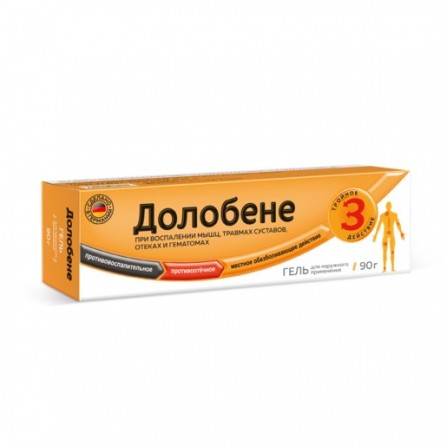More info
Active ingredients
Composition
Pharmacological effect
Dimethyl sulfoxide (DMSO)
DMSO has anti-inflammatory, anti-edematous and local anesthetic action. Anti-inflammatory activity associated with some pharmacological effects, the most significant of which is the inactivation of hydroxyl radicals, produced in large quantities during the process of inflammation and have a destructive effect on tissue.
DMSO has a local analgesic effect by reducing the speed of nociceptive (pain) impulses in peripheral neurons. The anti-edema effect is provided by the inactivation of hydroxyl radicals and the improvement of the subcutaneous metabolic reaction at the site of use of the drug. To a certain extent, the hygroscopic properties of DMSO are also responsible for its anti-edema action.
DMSO (from 50% or more) penetrates biological membranes, incl. through the skin, contributing to a better and deeper penetration into the tissue of other drugs used simultaneously with it.
Heparin
Heparin has an anti-inflammatory effect, promotes the regeneration of connective tissue by inhibiting the activity of hyaluronidase.
Heparin exhibits a dose-dependent antithrombotic effect, enhancing the inhibitory activity of antithrombin III in relation to the activation of prothrombin and thrombin.
The penetration of heparin through healthy skin is dose-dependent and is confirmed for dosage starting at 300 IU / g.
Dexpanthenol
When applied topically, dexpanthenol is transformed into pantothenic acid (vitamin B) in the skin. The effectiveness of dexpanthenol is comparable to that of pantothenic acid. Pantothenic acid as a component of coenzyme A is involved in various catabolic and anabolic processes in tissues; by improving the processes of granulation and epithelization, it promotes the regeneration of damaged skin.
Pharmacokinetics
DMSO
The physiological concentration of DMSO in normal blood plasma is 40 ng / ml.6 hours after the application of the drug, Cmax in the blood plasma reaches 120 ng / ml and lasts up to 12 hours after application. After 60 h after application, the concentration of DMSO in the blood plasma reaches a physiological level of 40 ng / ml.
12–25% of absorbed DMSO is excreted within the first 24 hours and 37–48% is excreted within 7 days unchanged or as a metabolite (dimethyl sulfone) via the kidneys. 3.5–6% of all DMSO is excreted through the lungs in the form of dimethyl sulfide 6–12 hours after the use of the drug.
When using 1 g of DMSO 3 times a day for 5 days, its average content at the site of application to the skin is 3 mg / g, the average content in the underlying muscle tissues and synovial membrane at the site of the synovial compound is 7–10 mcg / ml, in the synovial liquids - 0.8 mcg / g. The plasma concentration of DMSO is 0.5 μg / g. T1 / 2 DMSO is 11–14 h.
Heparin
When applied externally, heparin is absorbed slightly.
Dexpanthenol
When applied externally, dexpanthenol is transformed into pantothenic acid in the skin. Good absorption of dexpanthenol is confirmed experimentally.
Indications
- swelling, hematomas and inflammation of the soft tissues, muscles, tendons, tendon sheaths;
- closed injuries, bruises;
- joint injuries with sprains and tendons;
- shoulder epicondylitis ("tennis player's elbow"), tendinitis (tendon inflammation), tendovaginitis (tendon sheath inflammation), bursitis (inflammation of the mucosa of the joint bag);
- periarthritis of the shoulder joint;
- acute neuralgia.
Contraindications
- hypersensitivity to one of the components of the gel (active and / or excipients);
- bronchial asthma;
- severe violations of the liver, kidneys;
- pronounced disorders of the cardiovascular system;
- pregnancy;
- lactation period;
- age up to 5 years;
- open wounds at the site of application.
Use during pregnancy and lactation
Use during pregnancy. Since the research data on the use of the drug in pregnant women are not available, its use during pregnancy is contraindicated.
Application during lactation. DMSO penetrates into breast milk, so during the use of the drug should stop breastfeeding.
Dosage and administration
Locally.
Dolobene should be applied with a surface layer on the skin over the affected area of skin 2-4 times a day.
When using the gel under the dressing, apply the drug and wait a few minutes for it to be absorbed by the skin and the isopropanol evaporated. You can then apply a hermetic bandage.
Dolobene can be used in iontophoresis. The drug is applied under the cathode.
Dolobene as a contact gel can be used in ultrasound therapy (phonophoresis). Gel active ingredients complement the therapeutic effects of ultrasound waves.
The duration of treatment depends on the severity of symptoms and the severity of the disease.
Side effects
Local skin reactions are possible (redness, itching, burning sensation at the site of gel application), which usually disappear during further treatment.
Due to the content of DMSO or other components of the drug, an allergic skin reaction is sometimes possible.
In rare cases, during the use of the drug, some patients may smell of garlic from the mouth. The smell is caused by dimethyl sulfide, which is a product of DMSO metabolism.
A change in taste is possible, which disappears within a few minutes after applying the gel.
In isolated cases, the occurrence of immediate-type allergic reactions (urticaria, angioedema).
Extremely rarely, when applying the drug to large areas of the body, nausea, diarrhea, difficulty breathing, headache, chills are possible.
Overdose
Data overdose of the drug is not available.
special instructions
The place of application of the gel should be free from other drugs, cosmetics or any chemical agents. Dolobene should not be applied to the mucous membranes of the eyes, nose, mouth, open wounds or to damaged skin (due to radiation, severe sunburn), postoperative scars.
During treatment with the drug, the photosensitivity of the skin may increase, so during its use it is necessary to limit intensive sunbathing and a visit to the tanning bed. In the event of skin reactions, treatment should be discontinued. Due to the high absorption of DMSO, Dolobene should not be used in combination with other ointments and gels.



